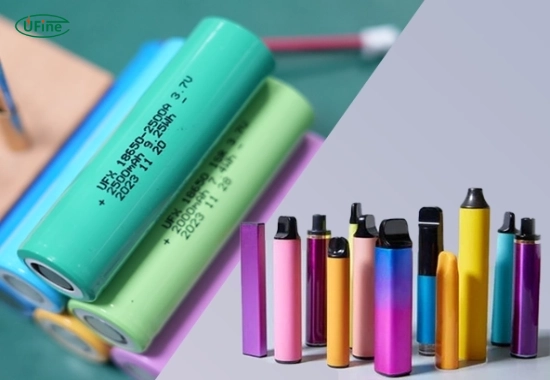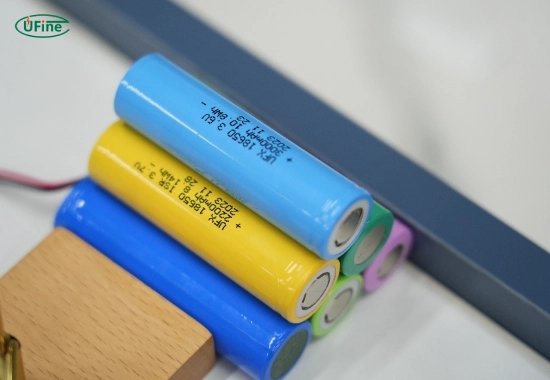The 18650 vape battery is pivotal in powering devices and determining performance, longevity, and safety. This guide delves into the critical aspects of selecting the ideal 18650 battery for vaping enthusiasts. From deciphering capacity and discharge rates to understanding compatibility and battery chemistry, this comprehensive overview equips users with the necessary insights to make informed decisions about their vape batteries.
Part 1. 18650 Vape battery
As one of the most commonly used battery types in vaping, 18650 vape battery specifications and capabilities significantly impact user satisfaction and device efficiency.
Specifications
Understanding the technical specifications is crucial for optimizing their vaping setup. This battery format typically boasts a cylindrical shape, 18mm in diameter and 65mm in length (hence the name “18650”), accommodating various vape devices. Moreover, it offers a range of capacities, discharge rates, and chemistries, allowing users to tailor their choices based on specific vaping needs.
Compatibility
One of the key strengths of the 18650 battery is its versatility. It’s compatible with a wide array of vape mods, providing users with options to fine-tune their vaping experience. From beginner-friendly devices to high-powered, advanced setups, these batteries are popular due to their adaptability across different vaping styles.
Battery Chemistry and Safety
1. Lithium-ion (Li-ion):
Widely prevalent in vape batteries, Li-ion offers a balanced mix of capacity, discharge rates, and overall performance. It’s known for its energy density, making it suitable for various vaping styles. However, safety precautions like avoiding overcharging or exposing it to extreme temperatures are essential to prevent the risks of overheating or venting.
2. Lithium-ion Polymer (LiPo):
LiPo batteries offer flexibility in shape and size due to their polymer electrolyte. They are commonly found in compact devices due to their slim and customizable form factor. Users benefit from high discharge rates, but proper handling is crucial as they can be sensitive to physical damage, potentially leading to safety hazards.
3. Lithium Manganese (IMR) and Lithium Nickel (INR) Variants:
IMR (Li-Mn) batteries are renowned for their safety features, boasting stability even under stress conditions. They have lower energy density but offer enhanced safety margins, making them suitable for users prioritizing safety in their vaping setup.
INR (Li-Ni) batteries strike a balance between capacity and safety. They offer moderate energy density while maintaining stability, suitable for users seeking a blend of performance and safety.
Safety Precautions for 18650 Batteries:
- Using dedicated chargers designed for 18650 batteries.
- Avoiding overcharging or discharging batteries completely.
- Storing batteries in appropriate cases to prevent short circuits.
- Avoid exposure to extreme temperatures to prevent thermal runaway.
Part 2. How to choose the 18650 vape battery?
Battery Capacity
- mAh Rating: Battery capacity, measured in milliampere-hours (mAh), signifies the energy storage capacity of an 18650 vape battery. Higher mAh ratings generally imply longer usage times before requiring a recharge.
- Vaping Habits: Understanding personal vaping habits is crucial when considering battery capacity. Heavy users or those who prefer extended vaping sessions typically benefit from higher-capacity batteries (2500mAh to 3500mAh). In contrast, casual users might find lower capacity options (1500mAh to 2500mAh) sufficient.
- Device Compatibility: Different vape devices have varying power demands. Matching the battery’s capacity with the device’s power requirements ensures compatibility and optimal performance. High-powered mods or sub-ohm devices often require batteries with higher capacities.
Battery Discharge Rate
- Continuous Discharge (C): Discharge rate, denoted as a multiple of the battery’s capacity (C), indicates how quickly the battery can release energy. Higher C ratings signify higher discharge rates, enabling the battery to handle more power-demanding situations.
- Power Output: Devices designed for sub-ohm vaping or those requiring higher wattages demand batteries with higher discharge rates (commonly 15A to 30A). This ensures the battery can handle the power demands without straining or overheating.
- Balancing Capacity and Discharge Rate: Achieving a balance between capacity and discharge rate is crucial. Higher capacity batteries might have lower maximum discharge rates due to their internal construction, so users must consider the appropriate balance between these factors for their specific vaping needs.
Compatibility with Vape Devices
- Device-Specific Requirements: Vape devices vary significantly in their power needs, sizes, and functionalities. It’s crucial to check the manufacturer’s specifications or user manuals to understand the requirements for compatible batteries. Some devices require specific voltage ranges, discharge rates, or physical dimensions to be matched precisely for safe and efficient operation.
- Battery Size and Fit: The 18650 vape battery’s physical dimensions (18mm in diameter and 65mm in length) typically fit many vape mods, but variations might exist. Some devices have compartments designed for specific battery sizes, and using an incompatible size could result in poor fitment or safety issues. Ensuring the battery fits snugly within the device’s compartment is essential for safe usage.
- Voltage and Output Requirements: Different vape devices operate at varying voltage ranges. Understanding the device’s voltage requirements helps you choose batteries that match these specifications. Mismatched voltages could impact device performance or safety. Additionally, devices with variable wattage or temperature control settings might have specific requirements for optimal performance.
- Discharge Rate Compatibility: Vape devices with different power output capabilities demand batteries with suitable discharge rates. Higher-powered devices, especially those designed for sub-ohm vaping, necessitate batteries with higher discharge rates (typically 15A to 30A) to handle increased power demands. Ensuring the battery’s discharge rate aligns with the device’s requirements prevents potential safety hazards or performance issues.
- Manufacturer Recommendations: Manufacturers often provide guidance on compatible batteries for their devices. Following their recommendations ensures optimal performance, safety, and longevity of both the battery and the vape device. Ignoring manufacturer recommendations might void warranties or lead to device malfunctions.
Part 3. FAQs
-
How do I choose an 18650 battery?
Consider factors like capacity (mAh), maximum continuous discharge rate (amps), brand reputation, and suitability for the intended device. Select a high-quality battery from reputable brands, ensuring it meets your device’s current and safety requirements. -
How do I know what battery to get for my vape?
Check your vape device’s manual or specifications for recommended battery types, considering discharge rate, capacity, and compatibility factors. Choose batteries designed explicitly for vaping to ensure safety and optimal performance. -
Do all 18650 batteries work for vapes?
Not necessarily. While many 18650 batteries can work for vapes, it’s crucial to select batteries that meet the power and discharge requirements specified by your vape device’s manufacturer to ensure safe and efficient operation. -
How long do 18650 batteries last in vapes?
The lifespan of 18650 vape batteries varies based on usage, charging habits, and the battery’s quality. They may last around 200 to 300 charge cycles on average, but this can significantly differ based on usage patterns. -
What is the 18650 battery for a vape?
Look for high-quality 18650 batteries designed for high-drain applications. Batteries from reputable manufacturers with high mAh ratings and suitable amp limits for your vape device’s power requirements are recommended for vaping.
Related Tags:
More Articles

LiPo Battery Discharge Rate Guide & Calculation Tips
Understand LiPo battery discharge rates, C-ratings, and how to calculate max current. Essential guide for RC, drones, and electronics users.
High‑Capacity 3S LiPo Batteries: 5000 mAh vs. 10000 mAh
Compare 3S LiPo 5000mAh vs 10000mAh batteries by weight, power, and use. Find the best fit for your drone, RC car, or boat setup.
Top 5 Applications for Small 3S LiPo Batteries
Small 3S LiPo batteries power drones, RC gear, wearables, and robotics with high energy and low weight. Making them ideal for compact electronics projects.
Building and Charging Your Own 3S LiPo Pack: A Step‑by‑Step Guide
Learn how to build, balance, and charge a 3S LiPo battery pack safely at home with this complete DIY guide for hobbyists and beginners.
How to Choose the Right LiPo Battery Plug Type?
Discover the best LiPo battery plug types, how to choose them, and expert tips for safe usage, soldering, and maintenance.






